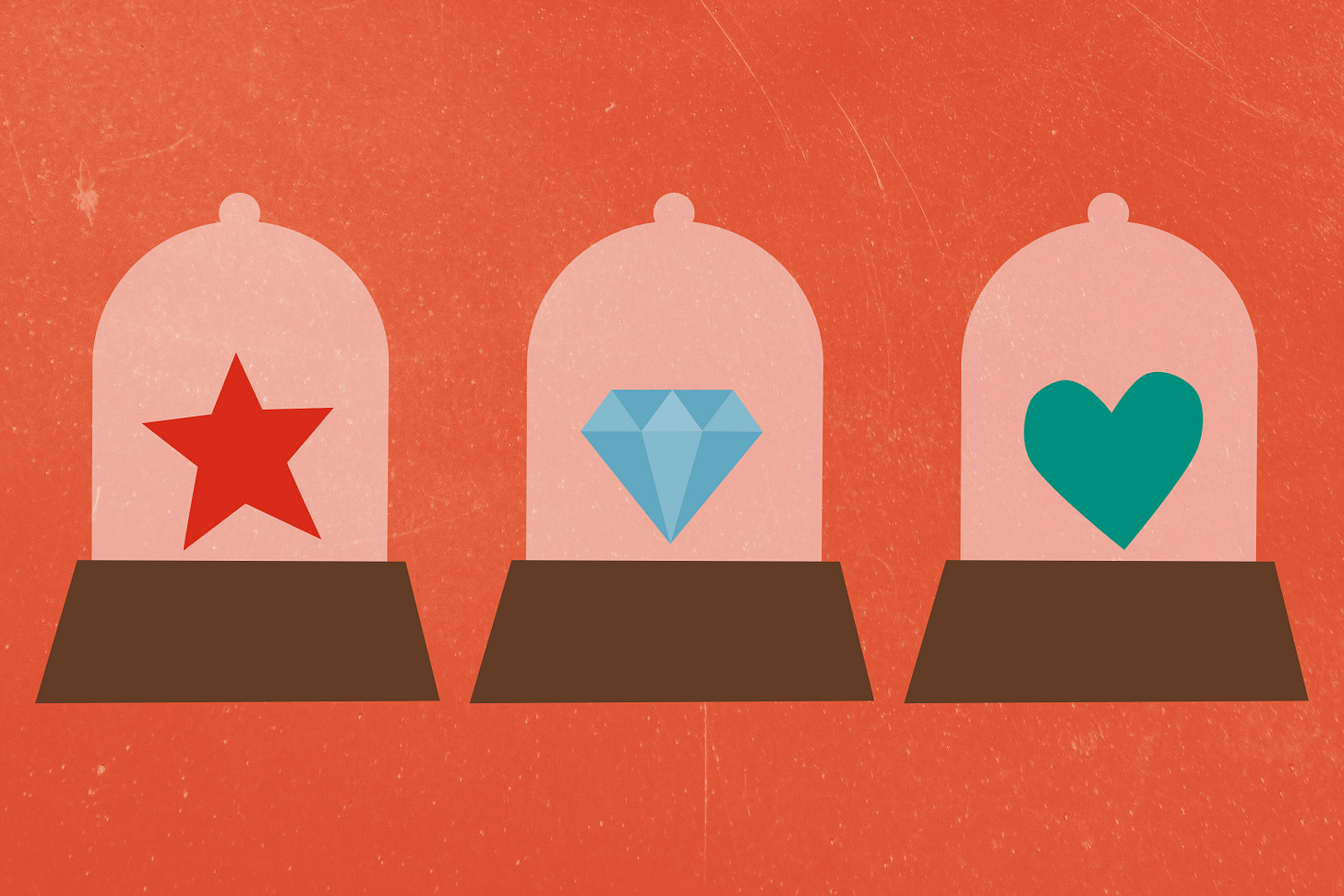🎉 Everything you need to know about Mementos but were afraid to ask—Part 3
We explore the Memento review process and how to assure a smooth and speedy approval.
Oh hey! Before we dive in, would you look at that? 🎬
Our 5th Slate starts tonight at 7 PM PT with Abbott Elementary!
Then on Thursday at 7 PM PT, we start the Star Wars film franchise.
And this Saturday, at 10 AM PT we return to the 90s with Dawson’s Creek.
All events will happen in the Remarkist App in our new Audio Dens. If you don’t have our app, install it from here! Then sign up for an account if you don’t have one already. You’ll be put on a waiting list, but don’t worry. We’ll get you in the app before the start of our watch tonight! And please share the news with others!
In our previous article, we talked about the building blocks of Memento creation: icon, title, description, password, number of editions and density. Now you’re ready for the approval process.
So you’ve just designed your proudest Memento to date. The icon is perfect and sits atop a gorgeous background and border combination. You’ve penned a brilliant follow-up to the event—going deeper into some of the ideas discussed. You even found a way to weave in clues for your collectors to crack the password! You’ve been working on it for a week, saving multiple drafts, and now you’re finally ready to hit that “Craft” button. So you do. What now?
You wait. ⏰ Your Memento has been crafted. You’ve even been charged the Mint and Craft fee. But it’s not ready to distribute yet.
After officially crafting your Memento, it enters a queue waiting for a team of community members to review it. Every Memento must go through a short approval process. You can help accelerate that process during slower periods by using a unique channel on our Discord server called #please-approve to alert our reviewers about your newly crafted Memento.
Two team members review every Memento. The first reviewer to take a pass will alert other team members that it is ready for a second set of eyes. 👀 The second reviewer will either approve the Memento or raise an issue with the rest of the team for potential denial.
Before denying a Memento, the team always discusses the issue and decides collectively how to explain their choice to the creator. Once they’ve agreed, one of the members will deny the memento and write an explanation, including how the creator can fix the issue.
Upon denial, the Mint and Craft fee is refunded, and the Memento becomes a draft again. The note from our reviewer can be found just before entering the Memento constructor to make further edits.
We’ve had a Memento approval process for quite some time, but we haven’t shared our criteria, so hopefully, this article demystifies the process a bit.
Memento Approval Criteria
We consider Mementos a kind of published product. Remarkist is your publisher, and you give us the right to distribute your works to collectors on the Remarkist platform. Just as Random House has its name and reputation on every novel it publishes, so do we. This review process ensures that your Memento wholly belongs to you, meets standards of decency for a mainstream platform like ours, and adheres to a few formatting rules. We look for three things ☑️:
Does the content infringe on someone’s rights?
Is the content abusive?
Does its icon include title-style text?
Infringing Rights
The most common denial happens when a Memento infringes on trademark, copyright, or likeness rights. For the past 20 years, social platforms have had a laid-back approach to user-generated content. For that reason, most users on social media have gotten accustomed to sharing screenshots and logos from their favorite franchises. But Remarkist members are not “users.” They’re members, collectors, artists, and authors. Mementos are not just digital badges or stickers depicting our favorite stories. Mementos represent a creator's perspective, and therefore, Mementos are the creator’s art and literature. So that’s what we’re looking for—is this yours? Or are you using something that belongs to someone else who hasn’t given you the right to incorporate it into your art and lit? Here are our guidelines:
The title of a Memento cannot include any words that are trademarked (or likely to be trademarked—such as character names or company names) if the title is referencing that trademark.
For example, you can’t have the word Nike in your Memento title if it is clear that your Memento is referencing sneakers. That would mean your title references the Nike sneaker company and its Nike trademark. However, if your Memento is not about sneakers and instead references Greek Mythology, then using the word Nike (the Greek goddess of victory) would be fine.Your icon cannot include any copyrighted or trademarked imagery, the image of private property, or the likeness of someone.
You can’t use an image of Spider-Man or something that looks a lot like Spider-Man. You can’t use a picture of a nondescript face with circle glasses that has Harry Potter’s signature forehead scar. You can’t use Burger King’s logo or something that looks a lot like Burger King’s logo. You can’t use the fictitious logo for the Dharma Initiative from the television show Lost. If your Memento references Lost in any way, you can’t even use a shape vaguely resembling the Dharma Initiative logo. You can’t use an image of Julia Roberts or a rendering meant to be Julia Roberts. You can’t use an image resembling the EPCOT center sphere or a drawing of someone’s custom-designed house.
Suppose your icon depicts something unique, and you did not design that one-of-a-kind thing. In that case, you cannot use it, nor an approximation of it, without the permission of the person who owns it—unless it is in the public domain or is distributed under a CC0 license.
The good thing about icons is that most of our catalog comprises standard emojis, which usually clears them of these issues. There are still some cases, though, where even the emoji you choose is too similar to a unique story element, and in that case, it might be denied.Your Memento’s entire background, border, and icon arrangement cannot resemble a copyrighted design.
If you choose a red background, a blue border, and a spider web emoji 🕸for your icon, this will have a striking similarity to the copyrighted look of the trademarked character Spider-Man. A blue background, with a red border and a standard red upside-down triangle emoji 🔻looks a lot like Superman and would not be permitted on a Memento that references Superman.If your Memento description is written as non-fiction commentary, it must contain at least 50% of your own written voice in your own words.
As Remarkists, we comment on and review the works of others. This gives us the same rights afforded to journalists and academics to include trademarked words, quotes, and copyrighted text in our analysis, criticism, and summary of another person’s work. However, if the amount of copyrighted text exceeds 50% of the description, we consider it a rights infringement. If you copy and paste a script section, even if you put it in quotes, include the source, and follow it with, “I love that scene,” you are asking us to mostly publish someone else’s work. We need you to give us at least as much commentary about that scene for us to deem it yours.If your Memento description is written as fiction, it cannot contain any copyrighted elements—including character names, location names, or any names of unique objects from another story.
All stories have indeed been told before. But that just means the underlying structure of a story is not ownable. Tropes, story conventions, genres, given circumstances, and even general plots are not easily copyrightable. However, the unique elements of a storyworld are. There are countless small towns with diners. And there have been plenty of stories about them. But Stars Hollow, Lorelai Gilmore, and Luke Danes are original elements of a storyworld. You can use the tropes and story conventions they represent, but you cannot give them names uniquely devised by someone else. So either leave them nameless or devise your own names for them. We don’t allow fan fiction that includes proper names or describes unique story elements from another person’s story. Depicting a nameless guy in a red and blue jumpsuit with a spider 🕷 logo on his chest swinging from buildings with webs he shoots out of his wrists is… describing a uniquely conceived character. Even just webs out of wrists alone would be a no-go.
Appropriate Content
We don’t want to hinder free expression, and we realize that decency standards change over time. But still, there are reasonable rules for what can be deemed inappropriate.
You cannot use a Memento to harass someone, belittle them, harm their reputation, or attack them in any way.
Aside from the fact that it’s not nice, we take libel and defamation seriously. If your Memento description or icon suggests something abusive or harmful to another person or their reputation, especially if it is based on an allegation, it won’t be approved. We will also not approve a Memento that includes any discrimination by the author.You can’t include graphic violence.
Yes, what one person considers lewd, another might consider tasteful art. We haven’t run into this problem yet. But we do have an ecosystem-wide code of conduct that extends to Mementos, and the inclusion of graphic, disturbing material is a no-go.
Text in Icons
We are still developing the Memento system, and more changes will come. But in our early days, we’ve placed at least one restriction on the Memento style. Text in icons should be part of the icon itself rather than a title for the icon or a heading for the Memento. Adding text to the image of a Memento can create title redundancy. Icons should be symbolic… like an emoji or glyph.
That doesn’t mean you can’t use text. It just means the text has to be incorporated in a way that is a logical part of the icon. For example, you cannot use the words For Sale as your icon. You cannot use an icon of a house with the words For Sale above or below it. Both examples would be titles and should only live in the Memento’s Title or Description field. However, you can use an icon of a For Sale sign, and that sign would need the words “For Sale” printed on it to be recognizable as such.
So if you can make the case that the text would logically exist within the object depicted by the icon itself, you’re good to go.
Revising your Memento
There’s no limit to how many times you may be asked to revise a Memento. But something to consider is that Mementos have a deadline for being crafted. While you can design and craft a memento well before the start of your event, it must be crafted no later than one week 🗓 after the start of the event—otherwise, you lose the ability to craft and drop it.
Each approval process can take a few days, so if your Memento is still waiting for approval—or has been sent back to your Memento constructor—when that one-week deadline passes, you will be refunded the Mint and Craft fee, and the Memento and Constructor will disappear. So crafting your mementos early and remembering the rules above will help you avoid any delays or losses.
In our next installment, we’ll discuss what happens after your Memento is approved and how you can prep it for others to claim.






